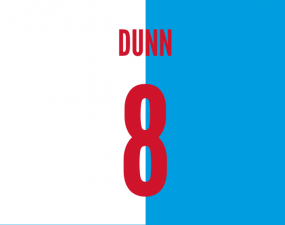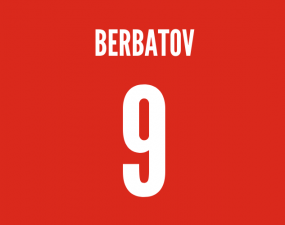Player Profile: Robin van Persie
Date of Birth: 06/08/1983
Height: 6 ft (1.83 m)
Position: Striker
National Team: Netherlands
International Caps: 102
International Goals: 50
Club Career
Born in Rotterdam, Robin van Persie began his career at his local club Feyenoord, where he made his first team debut at the age of 17. He began his career playing on the left wing, where he demonstrated his excellent dribbling skills, calm finishing and knack for set pieces.
After breaking through he appeared regularly for the club and would go on to score 22 goals in 78 appearances in all competitions. He was also part of the side that lifted the UEFA Cup in the 2001-2002 season.
But it wasn’t all rosy for van Persie. He would see spells on the bench and in the reserves after disciplinary problems and arguments with the team’s manager. These problems escalated so much that Feyenoord looked to sell the young Dutchman, and after a prolonged period of negotiations he would move to Arsenal in the summer of 2004.
Costing £2.75 million at 20 years old, van Persie was seen as the eventual successor to Dennis Bergkamp. Arsène Wenger looked to mould him into a key part of the Arsenal strike force, converting him from a winger into a striker as he had done so successfully with Thierry Henry.
At the beginning of his Arsenal career van Persie struggled with niggling injuries, and with strong competition for places he often started games on the bench. His disciplinary issues also resurfaced, as he received a red card for a reckless lunging tackle. Despite this, he still ended the season having contributed a respectable ten goals.
Van Persie’s early Arsenal career would continue to show promise before being curtailed by injury on multiple occasions. He scored one of his most memorable goals against Charlton in the ‘06/07 season, an athletic volley from outside the box, and his season looked to be going from strength to strength. But injury hit again, and he missed most of the season with a damaged metatarsal.
The following season Henry would leave the club, and van Persie became Arsenal’s main man up front. He took on this role confidently and was scoring regularly for the Gunners, but again was frustratingly sidelined by more injury problems. This would unfortunately continue for the next few seasons.
However, van Persie would continue to show just how valuable he was to the team when fit. For example, in January 2009 he scored or assisted every single goal scored by Arsenal. He only managed to make over 40 appearances in a season three times during his eight seasons with the club. But his goals to games ratio was always exceptional.
He finally came into his own at the back end of the ‘10/11 season, when uninterrupted by injury he scored 18 goals in 17 matches. But he was just getting started. The following campaign would be one of the finest ever seen in Arsenal colours. He scored 37 goals in all competitions, including 30 in the Premier League which would earn him the Golden Boot and the PFA Player of the Year award. Despite van Persie’s incredible efforts in what would be his only season as captain, Arsenal still finished in 3rd place, well off the pace of the two Manchester clubs.
At the end of the season, van Persie announced he wouldn’t be signing a new contract at Arsenal, and it became clear he would be leaving the club in that transfer window. In a move that was very unpopular with the Arsenal fan base, he was transferred to Manchester United for a sum of £24 million.
During his eight years at Arsenal, van Persie would win only a solitary FA Cup in his first season. One of the main reasons he gave for leaving Arsenal was his desire to win the Premier League, and he would go on to achieve this goal at his new club on his first attempt.
He again had a stellar season and fired the Red Devils to the title. Van Persie’s deadliness in front of goal was shown again, as he scored 26 goals in the Premier league to take home his second Golden Boot in a row. Manchester United were criticised for bolstering their strike force with an injury prone striker, but van Persie proved his doubters wrong by gunning the club to the title.
The following season would see Sir Alex Ferguson’s retirement, and consequently a drop in the number of appearances for van Persie under new manager David Moyes. Manchester United would struggle to adapt under Moyes and would finish the season 7th in the Premier League, but van Persie still bagged a strong goal tally, scoring 18 goals in 28 games in all competitions.
With David Moyes replaced by Louis van Gaal the following season, van Persie would again find himself not at the forefront of his managers plans. The writing was on the wall, and at the end of the campaign he moved to Turkish giants Fenerbahce.
The Dutchman was popular with the Istanbul clubs passionate fans, but still had to earn his place in the team. Often appearing from the bench at the beginning of his spell there, he still managed a tally of 22 goals in all competitions in his first season. His game time would diminish in the following two seasons and he cancelled his contract with the club in January 2018 to return to his boyhood club Feyenoord.
Van Persie remained a goal scoring threat in his second spell at the Rotterdam club, and was the clubs top scorer in his final season before retirement. He retired with over 250 goals for club and country, a number that would be even higher if it weren’t for his struggles with injury.
His career finished with UEFA Cup and Dutch Cup wins with Feyenoord, an FA Cup triumph with Arsenal and a Premier League winners medal with Manchester United. He will be remembered as one of the deadliest strikers of his generation.
International Career
Robin Van Persie’s first cap for the Netherlands came at the age of 21 in a World Cup qualifier versus Romania. He played frequently in the qualifiers and in the full tournament in 2006, where he scored against the Ivory Coast as the Netherlands were knocked out in the round of 16.
He would compete for a place with Arjen Robben behind lone striker Ruud van Nistelrooy in the run up to Euro 2008, and continued to bag several goals from the wing. But the Oranje would again be eliminated in the first knock out round of the tournament.
The Netherlands entered the 2010 World Cup with a 100% record, and carried this form into the tournament all the way to the final, with van Persie starting every game. Sadly he wouldn’t finish a World Cup winner as the Dutch lost to Spain in extra time of an ill-mannered final.
After a Euro 2012 to forget when the Dutch were knocked out in the group stages, the Netherlands were more successful in the 2014 World Cup making it to the semi-finals before losing to Argentina.
Van Persie would score one of his most memorable goals in this tournament, an acrobatic diving header that looped over the keeper. The goal would go on to be nominated for a Puskas Award. He would never play in another tournament for his country, and would retire as their leading scorer, with 50 goals in 102 appearances.
Where is Robin van Persie now?
In the short span of time since he retired, van Persie has been working as a pundit for BT Sports, appearing in Premier League and European broadcasts. He has said that he hasn’t decided whether he will go into coaching, but may do in the future.




